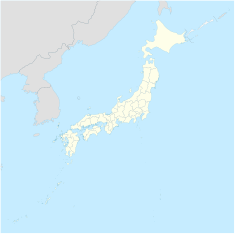
A dam is a barrier that stops or restricts the flow of surface water or underground streams. Reservoirs created by dams not only suppress floods but also provide water for activities such as irrigation, human consumption, industrial use, aquaculture, and navigability. Hydropower is often used in conjunction with dams to generate electricity. A dam can also be used to collect or store water which can be evenly distributed between locations. Dams generally serve the primary purpose of retaining water, while other structures such as floodgates or levees are used to manage or prevent water flow into specific land regions.
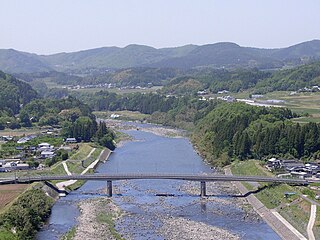
The Ōno River is a river that originates in Ōita Prefecture, Japan. After running through the southern and central portions of Ōita Prefecture, it runs through the eastern part of Kumamoto Prefecture and the northern part of Miyazaki Prefecture.
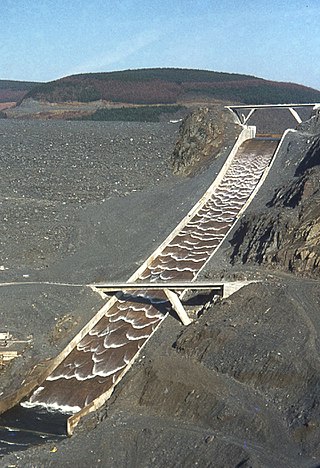
A spillway is a structure used to provide the controlled release of water downstream from a dam or levee, typically into the riverbed of the dammed river itself. In the United Kingdom, they may be known as overflow channels. Spillways ensure that water does not damage parts of the structure not designed to convey water.

The Shinano River, known as the Chikuma River in its upper reaches, is the longest and widest river in Japan and the third largest by basin area. It is located in northeastern Honshu, rising in the Japanese Alps and flowing generally northeast through Nagano and Niigata Prefectures before emptying into the Sea of Japan. It is designated as a Class A river.
Shintoho Co. Ltd. was a Japanese movie studio. It was one of the big six film studios during the Golden Age of Japanese cinema. It was founded by defectors from the original Toho company following a bitter strike in 1947.
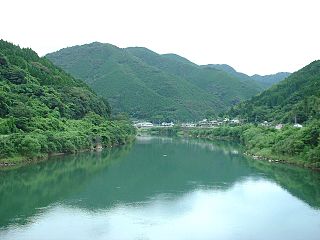
The Kuma River is a river in Kumamoto Prefecture, central Western part of Kyūshū, Japan. It is sometimes referred as Kumagawa River. It is the longest river in Kyushu, with the length of 115 km long and has a drainage area of 1,880 km2 (730 sq mi). The river's estuary was designated part of Japan's 500 Important Wetlands.

Malampuzha Dam is the second largest dam and reservoirs in Kerala, located near Palakkad, in the state of Kerala in South India, built post independence by the then Madras state. Situated in the scenic hills of the Western Ghats in the background it is a combination of a masonry dam with a length of 1,849 metres and an earthen dam with a length of 220 metres making it the longest dam in the state. The dam is 355 feet high and impounds the Malampuzha River, a tributary of Bharathappuzha, Kerala's second longest river. There is a network of two canal systems that serve the dam's reservoir of 42,090 hectares.
Kazuko Shirakawa is a Japanese actress who is best known for her appearances in Nikkatsu's Roman Porno films during the 1970s. She appeared in Nikkatsu's first film in the Roman Porno series, Apartment Wife (1971), and is considered the first of the three "Nikkatsu Queens" of the 1970s. After 1976 she embarked on a successful career in mainstream film.
Fumiko Nakajō was a Japanese tanka poet.

The Sagami River is a river in Kanagawa and Yamanashi Prefectures on the island of Honshū, Japan.
Young Breasts is a 1958 Japanese juvenile delinquent film directed by Seijun Suzuki for the Nikkatsu Corporation. Akira Kobayashi stars as a young hoodlum who tries to go straight after falling in love with his social worker.

The Samanala Dam is a dam primarily used for hydroelectric power generation in Sri Lanka. Commissioned in 1992, the Samanalawewa Project is the third-largest hydroelectric scheme in the country, producing 405 GWh of energy annually. It was built with financial support from Japan and the United Kingdom. It is notable for a large leak on its right bank. Power production continues as planned despite the leakage, and the water from the leak now provides two thirds of the water issued by the reservoir for agriculture in downstream areas.

Rope and Breasts is a 1983 Japanese film in Nikkatsu's Roman porno series, directed by Masaru Konuma and starring Nami Matsukawa.

The Gōnokawa River is a river that runs through Hiroshima and Shimane prefectures in Japan. It is the largest river in the Chūgoku region. It is also called the Gōgawa River and, in Hiroshima, the Enokawa River.
Water supply and sanitation in Japan is characterized by numerous achievements and some challenges. The country has achieved universal access to water supply and sanitation, has one of the lowest levels of water distribution losses in the world, regularly exceeds its own strict standards for the quality of drinking water and treated waste water, uses an effective national system of performance benchmarking for water and sanitation utilities, makes extensive use of both advanced and appropriate technologies such as the jōkasō on-site sanitation system, and has pioneered the payment for ecosystem services before the term was even coined internationally. Some of the challenges are a decreasing population, declining investment, fiscal constraints, ageing facilities, an ageing workforce, a fragmentation of service provision among thousands of municipal utilities, and the vulnerability of parts of the country to droughts that are expected to become more frequent due to climate change.
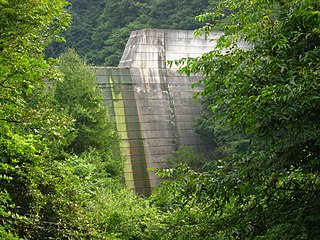
Amekawa Dam is a check dam on Ame river in Saku, Nagano Prefecture, Japan. The primary purpose is reducing water flow velocity to counteract erosion. It is also used for water supply.

The Shin-Takasegawa Pumped Storage Station (新高瀬川発電所) uses the Takase River to operate a pumped storage hydroelectric scheme about 12 kilometres (7.5 mi) west of Ōmachi in Nagano Prefecture, Japan. Part of the system is within Chūbu-Sangaku National Park.
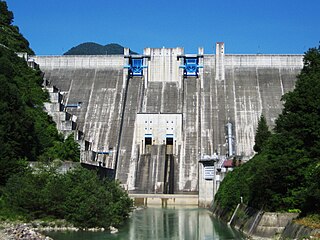
The Ōmachi Dam is a concrete gravity dam on the Takase River just west of Ōmachi in Nagano Prefecture, Japan. Construction of the dam began in 1975 and it was completed in 1985. The primary purpose of the dam is water supply and it also supports a 13 MW hydroelectric power station. It is owned by TEPCO.

Miure (Miura) Dam is a dam in the Nagano Prefecture, Japan, completed in 1945.
